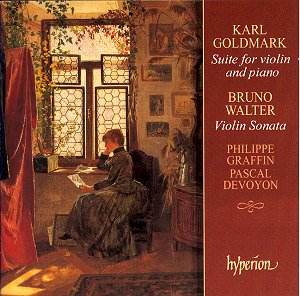The first thing to say about this new issue is that
it has really spectacular recorded sound. So both pieces sound excellent,
with real presence and an ideal ambience for this instrumental pairing.
Full marks to the Hyperion engineers and producer, and full marks too
for the company's enterprise in recording this unusual repertoire, in
compositions by musicians with Viennese connections, whose careers took
them much further afield too.
Bruno Walter is best known to us as a conductor, many
of whose performances remain in today's catalogue a generation or more
after they were made. This itself is testimony to his importance and
calibre as a musician. The insert notes accompanying a recording take
on a new interest when the music is little known, of course, and the
stalwart efforts of Martin Anderson deserve praise in unearthing so
many interesting facts about Walter. It does seem surprising, however,
that no mention is made of his having been Mahler's protégé
and that it was Mahler who brought him to Vienna from Hamburg.
As a composer Walter had all the appropriate training,
but eventually decided that his creative efforts did not rate as highly
as his performing career. On hearing this duo sonata, it is tempting
to sympathise with his view. It is quite a substantial piece, more than
thirty minutes long, knowingly put together and always sounding right.
But somehow it doesn't seem to add up to much. None of the ideas is
particularly striking, and it gave me the impression it is very typical
of its period without having a great deal to say. This judgement did
not change on subsequent hearings, although the performance by Graffin
and Devoyon is thoroughly professional.
Goldmark's Suite dates from 1869, and is more direct
and ingratiating. It makes no attempt at profundity, but the melodic
lines are appealing and there is a certain vitality in the faster movements
which balances well against the more introspective aspects of the work.
He was a composer with a strong instinct for melody and instrumental
colour, and these artists take advantage of their opportunities to give
a most enjoyable performance.
Terry Barfoot


